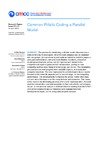The process for developing a climate model often involves a wide community of developers. All of the code releases can be classified into two groups: (i) improvements and updates related to modeling aspects (new parameterizations, new and more detailed equations, remove of model approximations, and so on); (ii) improvement related to the computational aspects (performance enhancement, porting on new computing architectures, fixing of known bugs, and so on). The developing process involves both programmers, scientific experts, and rarely also computer scientists. The new improvements and developments are mainly focused on the scientific aspects and, in second stage, on the computing performance. The developments to improve the physic model often does not care about its impacts on the computational performances. This poses some issue in the developing process; after a new implementation, the code must be revised after new implementation to face out with the performance issues.
In this work we analyze 5 different releases starting from the NEMO v3.2 (to be considered as our reference) and evaluate how new developments impact on the computational performances.
The research leading to these results has received funding from the Italian Ministry of Education, University and Research and the Italian Ministry of Environment, Land and Sea under the GEMINA project.
CMCC Offices


